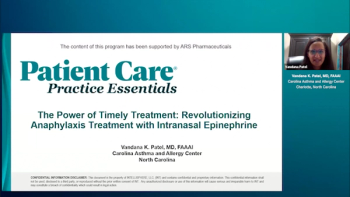Vandana K. Patel, MD, FAAAAI
Articles by Vandana K. Patel, MD, FAAAAI

A panelist emphasizes that shared decision-making in anaphylaxis management is essential, combining evidence-based guidelines with individual patient circumstances and preferences—especially regarding newer options like intranasal epinephrine—to ensure timely, confident use while addressing practical concerns, such as access, cost, and education.

A panelist highlights how neffy, a needle-free, portable intranasal epinephrine device, addresses key unmet needs by reducing needle anxiety, enabling easy use by nonmedical caregivers, offering longer shelf life and temperature stability, and improving timely administration to prevent severe anaphylaxis outcomes, as demonstrated in clinical case examples.

A panelist discusses that the intranasal epinephrine device causes only mild, expected adverse effects such as nasal discomfort and headache, avoids injection-related risks, demonstrates rapid symptom improvement in pediatric food challenge studies, and offers practical advantages such as higher heat tolerance for storage and a longer shelf life compared with traditional autoinjectors.

A panelist discusses a newly approved intranasal epinephrine device for treating anaphylaxis in both children and adults, highlighting its needle-free delivery using a nasal spray with an absorption enhancer that ensures effective, safe drug uptake comparable to injections—even under nasal congestion—offering a promising alternative to traditional epinephrine autoinjectors.

A panelist discusses how intranasal epinephrine represents a significant advance over traditional autoinjectors by eliminating needles, addressing user anxiety and real-world barriers, and potentially improving adherence and timely treatment in anaphylaxis emergencies.

A panelist discusses how barriers such as cost, fear of injections, and lack of confidence delay epinephrine use in anaphylaxis and explains how intranasal delivery and updated guidelines may reduce hesitation and improve timely, effective treatment through better education and accessibility.

A panelist discusses the critical importance of early epinephrine administration in anaphylaxis for preventing severe outcomes, explaining its multireceptor action and lifesaving potential, while highlighting how intranasal delivery could enhance timely use and empower caregivers with faster, more accessible treatment options.

A panelist discusses how intranasal epinephrine could transform anaphylaxis management by improving accessibility, reducing treatment delays, and addressing underuse of epinephrine—especially in pediatric and high-risk populations—while emphasizing the need for better education and more user-friendly interventions to improve outcomes.


